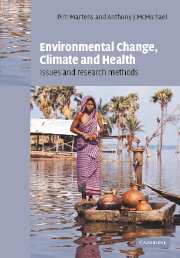Book contents
- Frontmatter
- Contents
- List of contributors
- Foreword
- 1 Global environmental changes: anticipating and assessing risks to health
- 2 Historical connections between climate, medical thought and human health
- 3 The contribution of global environmental factors to ill-health
- 4 Surprise, nonlinearity and complex behaviour
- 5 Epidemiological and impacts assessment methods
- 6 Retrospective studies: analogue approaches to describing climate variability and health
- 7 Detecting the infectious disease consequences of climate change and extreme weather events
- 8 Integrated Assessment modelling of human health impacts
- 9 Remote sensing, GIS and spatial statistics: powerful tools for landscape epidemiology
- 10 Monitoring the health impacts of global climate change
- 11 Epidemiology, environmental health and global change
- 12 Dealing with scientific uncertainties
- Index
- Plate section
- References
3 - The contribution of global environmental factors to ill-health
Published online by Cambridge University Press: 28 July 2009
- Frontmatter
- Contents
- List of contributors
- Foreword
- 1 Global environmental changes: anticipating and assessing risks to health
- 2 Historical connections between climate, medical thought and human health
- 3 The contribution of global environmental factors to ill-health
- 4 Surprise, nonlinearity and complex behaviour
- 5 Epidemiological and impacts assessment methods
- 6 Retrospective studies: analogue approaches to describing climate variability and health
- 7 Detecting the infectious disease consequences of climate change and extreme weather events
- 8 Integrated Assessment modelling of human health impacts
- 9 Remote sensing, GIS and spatial statistics: powerful tools for landscape epidemiology
- 10 Monitoring the health impacts of global climate change
- 11 Epidemiology, environmental health and global change
- 12 Dealing with scientific uncertainties
- Index
- Plate section
- References
Summary
Introduction
In order to better understand the potential impact of global environmental change on human health it is necessary to accomplish two contrasting tasks. First, it is important to widen the conceptual structure by which health risks are evaluated to include a broader array of more distal risk factors than has been common in public health in recent years. In addition, to focus the analysis in terms that facilitate meaningful comparisons with other important risks to health, there is need to structure the analysis in absolute measures of ill-health and in terms of standard and emerging decision-making tools. Progress in both these arenas will be needed to effectively guide intervention policies.
To approach these tasks, we follow a temporal progression. First, we briefly examine historical views of human health and the environment to show that the challenges now created by global environmental change actually extend contemporary public health's scope into realms previously embraced by the field. We next offer an analytical structure for addressing the linkages and pathways between multiple social and ecological processes acting at various scales, ultimately influencing health. Issues of causality and capability lead us to examine how a disease-based, resource-effectiveness paradigm might be expanded to understand environment–health connections today. We quantify the current contribution of environmental risk factors to ill-health, and from this basis peer into the future. We discuss how attributable and avoidable risk calculations relate to public health planning, and the implications of incorporating considerations of net present value and sustainability.
- Type
- Chapter
- Information
- Environmental Change, Climate and HealthIssues and Research Methods, pp. 52 - 95Publisher: Cambridge University PressPrint publication year: 2002
References
- 1
- Cited by

